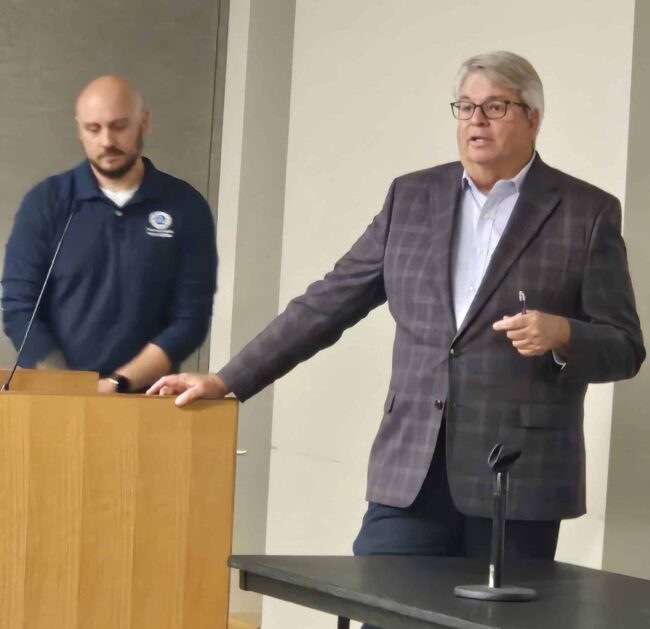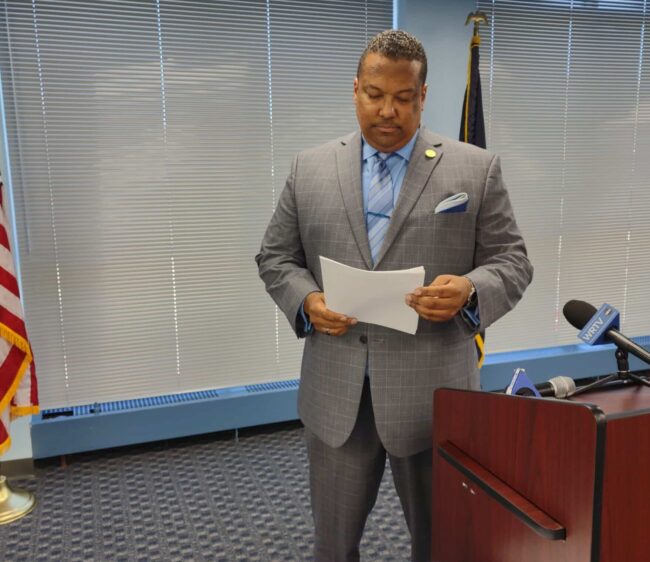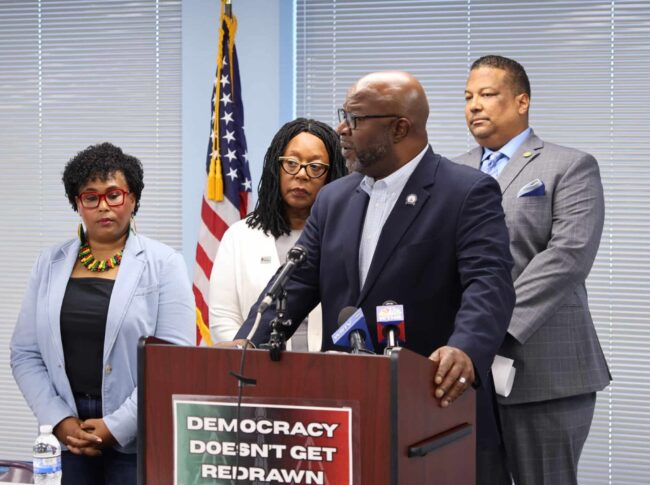
By Marilyn Odendahl
The Indiana Citizen
October 30, 2025
Minutes after Gov. Mike Braun announced on Monday he would call a special legislative session early next month for redistricting, state Democratic lawmakers began using just about the only tool they will have to fight the process in the Statehouse: their voices.
Democrats have been sounding off about congressional redistricting for months, talking at news conferences, chatting with constituents at town halls and listening sessions, and speaking out at protests. In response to the Republican governor’s special session announcement, they unleashed an outcry, calling the push for mid-decade redistricting a ploy to silence voters, rig the congressional maps, diminish minority voices, cover up the failed policies of the Trump administration, and put partisanship over people.
Although Democrats might get some help from the calendar and electoral math, they will have to rely on their voices to try to stop the Republican supermajority in the Indiana legislature from reconfiguring the state’s congressional districts in advance of next year’s midterm election when every member of Indiana’s delegation to the U.S. House will be on the ballot.
Holding just 30 seats out of the 100 legislators in the Indiana House and 10 out of 50 in the Senate, Democrats are so few in number in the General Assembly that they cannot derail redistricting. Their “no” votes alone will not be able to defeat any proposed new maps, they cannot stop the session by walking out, and their ability to influence the process is doubtful since any bills they introduce will likely not be heard and any amendments they offer will probably be tossed by the Republicans.
Aaron Dusso, chair of the political science department at Indiana University Indianapolis, said making a clear public statement that resonates with voters is about the best Democrats can hope to accomplish during the special session.
His advice to Democrats is to articulate how the mid-decade redistricting is a violation of democratic principles.
“It changes the democratic process from a situation where voters choose their representatives to representatives choosing their voters, and that’s not democracy,” Dusso said. “If you can get people to understand that, then at least you’ll have done something.”
Democrats in the legislature have demonstrated they intend to keep using their voices. Also, they continue to encourage Hoosiers to speak out in opposition of redistricting. As for any other plans they may have for combating the special session, Democrats are saying very little.

Speaking at a news conference in early October when Vice President JD Vance visited Indiana a second time to discuss redistricting with Republican lawmakers, Senate Minority Leader Shelli Yoder, D-Bloomington, and House Minority Leader Phil GiaQuinta, D-Fort Wayne, revealed a little of their party’s plans for a special session. GiaQuinta said the caucus would be trying to amend any redistricting bills and pushing for an independent commission, rather than the legislature, to redraw congressional and legislative district maps after each U.S. Census.
When asked whether the Democrats would be proposing their own redrawn congressional district maps, neither leader provided a direct answer.
“We are definitely in communication and talking and preparing, but that’s about as much as I can say about what we are going to propose,” Yoder responded. “We are in opposition to … rigging the maps, full stop.”
The Trump administration has been pressing Indiana Republicans to redraw the state’s congressional district maps for nearly three months. President Donald Trump has been strong-arming Indiana and other states with Republican-controlled legislatures to undertake a rare mid-decade redistricting in order to give GOP candidates an advantage in the 2026 midterm election and prevent the Democrats from taking over the U.S. House.
However, some Indiana Republican lawmakers have been reticent with several representatives and senators publicly announcing that they will not vote for any redistricting bills or new maps that are introduced during the special session. In fact, days before Braun called the special session, Senate Republican leadership said a majority of its members were not supportive of the effort to reconfigure the districts.
Rep. Earl Harris Jr., the chair of the Indiana Black Legislative Caucus, sees the split in the GOP caucus as providing an opening for Democrats’ voices to be heard and Hoosiers protests against redistricting to impact the special session.

The last time the Indiana General Assembly convened in a special session was in the summer of 2022 when the state’s abortion law was on the agenda mere weeks after the U.S. Supreme Court overturned a woman’s right to terminate her pregnancy in Dobbs v. Jackson Women’s Health Organization. Protesters descended upon the Statehouse and Democrats assailed the proposed legislation, but still the GOP supermajority passed a near-total ban on abortion.
Harris, D-East Chicago, said “a lot of our friends on the Republican side” were uniformly against abortion when the restrictions were passed in 2022, so personal stories, arguments and public outcry had little effect. With redistricting, he said, the supermajority is divided and the leadership has been unable to corral them into a “yes” vote, which gives an opportunity to the opposition.
In IBLC town halls, Harris said, the Democratic legislators have been getting in front of the people who voted them into office. He tells the constituents that “we represent you,” and he reminds them of their power by pointing out, “You can vote people out of office.”
“I think the importance is for people to understand the important role and the importance of their voice,” Harris said.
Chad Kinsella, associate professor of political science at Ball State University, pointed to the calendar as another potential arrow in the Democrats’ limited quiver. The special session, slated to being Nov. 3, has been called late in the year and could collide with Thanksgiving and the holiday season. As one strategy, he said, the superminority could try to slow the legislative process and draw it out which might push the Republican lawmakers to abandon redistricting because they want to be home for the holidays with their families.
Otherwise, Kinsella said, Democrats can only stir public anger over redistricting and possibly position themselves for next year’s election.
“They could fight it, call public attention to it, fundraise off it,” Kinsella said. They can really tee this all up, politically, for 2026. I think … that’s probably their best option.”
While Democratic representatives and senators will gain the most attention through their debates and speeches on the House and Senate floors, Dusso said they might have the most leverage in their behind-closed-door conversations with Republicans. Those private talks could likely have the members of the superminority giving a math lesson to their colleagues across the aisle.
Dusso looked at the margins on the percentages of Republican to Democrat voters in the state’s seven of nine congressional districts that are current held by the GOP. Should the legislature try to redraw the 1st and 7th Congressional Districts, which are currently held by Democrats, the Republican margins in the other districts could shrink. Dusso explained redistricting those two Democrat-leaning congressional districts could end up making the seven safe GOP districts that are now as much as 70% Republican voters to 30% Democrats, less reliable for the GOP in the future with margins of 55% Republican and 45% Democrat voters.
“If they’re going to try and get all nine (congressional seats), they’re going to have to spread out their own voters,” Dusso said of Republicans. “They’re going to all of a sudden add in hundreds of thousands of Democratic voters into these other formerly safe Republican districts. So that’s the danger.”
Complicating the redrawing process will be the numbers themselves, Dusso said. Likely the legislature will be using 2024 election turnout data to craft safe Republican districts for the 2026 contest, but those numbers will be inflated because many GOP voters were highly motivated to cast a ballot for Trump in the presidential race. Moreover, with next year being a midterm, Republicans will have to overcome the obstacles of fewer voters, including their supporters, going to the polls and the historical trend that the party in power losing congressional seats in non-presidential elections. Consequently, Dusso said, the vote totals in November 2026 could see “massive swings” of 10 to 15 points in favor of Democrats.
“Your voters are going to stay home and the worse the economy gets, the more they’re going to stay home,” Dusso said of Republican voters. “They’re not going to go vote. They’re not going to magically vote Democrat. They’re just staying home.”

Even with the electoral math appearing to go against Republicans, Sen. Greg Taylor, D-Indianapolis, noted Democrats would have to work very hard to flip any redrawn districts to blue. During a news conference organized by the Indiana Black Legislative Caucus, Taylor said electing a Democrat into a reconfigured district that includes a portion of the city of Indianapolis would require 70% of Marion County voters to turn out in the general election, but, currently, only 30% of the voters are casting ballots.
“Believe you me, we will not give up,” Taylor said. “We don’t have a history of doing that. This country was built on people fighting from under and rising to the top and we plan on doing that.”
Raising public awareness and getting Hoosiers to join the fight against redistricting appears to be a key part of the Democrats’ strategy. During the IBLC news conference, Harris said constituents who are concerned should voice their opposition to the governor and Republican legislative leadership and they should share information about redistricting with family and friends.
As for what Democrats will be doing during the session, Harris did not provide many details.
“We are having some preliminary conversations in preparation for that happening,” Harris said of the special session. “I don’t want to get into too much, as we’re still working out things, but we will have responses.”
Dwight Adams, an editor and writer based in Indianapolis, edited this article. He is a former content editor, copy editor and digital producer at The Indianapolis Star and IndyStar.com, and worked as a planner for other newspapers, including the Louisville Courier Journal.
The Indiana Citizen is a nonpartisan, nonprofit platform dedicated to increasing the number of informed and engaged Hoosier citizens. We are operated by the Indiana Citizen Education Foundation, Inc., a 501(c)(3) public charity. For questions about the story, contact Marilyn Odendahl at marilyn.odendahl@indianacitizen.org.